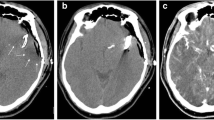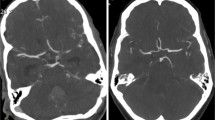Abstract
Introduction
With the development of computed tomography (CT) and magnetic resonance imaging (MRI), the use of conventional X-ray angiography including digital subtraction angiography (DSA) for diagnosis has decreased, as it is an invasive technique with a risk of neurological complications. However, X-ray angiography imaging technologies have progressed markedly, along with the development of endovascular treatments. A newly developed angiography technique using cone-beam CT (CBCT) technology provides higher spatial resolution than conventional CT. Herein, we describe the potential of this technology for neurosurgical operations with reference to clinical cases.
Methods
Two hundred twenty-five patients who received 80-kV high-resolution CBCT from July 2011 to June 2014 for preoperative examinations were included in this study. For pathognomonical cases, images were taken with suitable reconstruction modes and contrast protocols. Cases were compared with intraoperative findings or images from other modalities.
Results
We observed the following pathognomonical types: (1) imaging of the distal dural ring (DDR) and the surrounding structure for paraclinoid aneurysms, (2) imaging of thin blood vessels, and (3) imaging of both brain tumors and their surrounding anatomy. Our devised 80-kV high-resolution CBCT imaging system provided clear visualization of detailed anatomy when compared with other modalities in almost all cases. Only two cases provided poor visualization due to movement artifact.
Conclusion
Eighty-kilovolt high-resolution CBCT has the potential to provide detailed anatomy for neurosurgical operations when utilizing suitable modes and contrast protocols.






Similar content being viewed by others
Abbreviations
- CT:
-
Computerized tomography
- CTA:
-
Computed tomography angiography
- MRI:
-
Magnetic resonance imaging
- MRA:
-
Magnetic resonance angiography
- DSA:
-
Digital subtraction angiography
- CBCT:
-
Cone-beam CT
- DDR:
-
Distal dural ring
References
Vertinsky AT, Schwartz NE, Fischbein NJ, Rosenberg J, Albers GW, Zaharchuk G (2008) Comparison of multidetector CT angiography and MR imaging of cervical artery dissection. AJNR Am J Neuroradiol 29:1753–1760. doi:10.3174/ajnr.A1189
Tomandl BF, Klotz E, Handschu R, Stemper B, Reinhardt F, Huk WJ, Eberhardt KE, Fateh-Moghadam S (2003) Comprehensive imaging of ischemic stroke with multisection CT. Radiographics 23:565–592. doi:10.1148/rg.233025036
Mnyusiwalla A, Aviv RI, Symons SP (2009) Radiation dose from multidetector row CT imaging for acute stroke. Neuroradiology 51:635–640. doi:10.1007/s00234-009-0543-6
Miley JT, Taylor RA, Janardhan V, Tummala R, Lanzino G, Qureshi AI (2008) The value of computed tomography angiography in determining treatment allocation for aneurysmal subarachnoid hemorrhage. Neurocrit Care 9:300–306. doi:10.1007/s12028-008-9109-4
Akpek S, Brunner T, Benndorf G, Strother C (2005) Three-dimensional imaging and cone beam volume CT in C-arm angiography with flat panel detector. Diagn Interv Radiol 11:10–13
Mordasini P, Al-Senani F, Gralla J, Do D-D, Brekenfeld C, Schroth G (2009) The use of flat panel angioCT (DynaCT) for navigation through a deformed and fractured carotid stent. Neuroradiology 52:629–632. doi:10.1007/s00234-009-0556-1
Soderman M, Babic D, Holmin S, Andersson T (2008) Brain imaging with a flat detector C-arm: technique and clinical interest of XperCT. Neuroradiology 50:863–868. doi:10.1007/s00234-008-0419-1
Patel NV, Gounis MJ, Wakhloo AK, Noordhoek N, Blijd J, Babic D, Takhtani D, Lee SK, Norbash A (2011) Contrast-enhanced angiographic cone-beam CT of cerebrovascular stents: experimental optimization and clinical application. AJNR Am J Neuroradiol 32:137–144. doi:10.3174/ajnr.A2239
Blanc R, Pistocchi S, Babic D, Bartolini B, Obadia M, Alamowitch S, Piotin M (2012) Intravenous flat-detector CT angiography in acute ischemic stroke management. Neuroradiology 54:383–391. doi:10.1007/s00234-011-0893-8
Caroff J, Mihalea C, Neki H, Ruijters D, Ikka L, Benachour N, Moret J, Spelle L (2014) Role of C-Arm VasoCT in the Use of endovascular WEB flow disruption in intracranial aneurysm treatment. AJNR Am J Neuroradiol. doi:10.3174/ajnr.A3860
Kizilkilic O, Kocer N, Metaxas GE, Babic D, Homan R, Islak C (2012) Utility of VasoCT in the treatment of intracranial aneurysm with flow-diverter stents. J Neurosurg 117:45–49. doi:10.3171/2012.4.jns111660
Oikawa S, Kyoshima K, Kobayashi S (1998) Surgical anatomy of the juxta-dural ring area. J Neurosurg 89:250–254. doi:10.3171/jns.1998.89.2.0250
Matsumura Y, Nagashima M (1999) Anatomical variations in the origin of the human ophthalmic artery with special reference to the cavernous sinus and surrounding meninges. Cells Tissues Organs 164:112–121
Hashimoto K, Nozaki K, Hashimoto N (2006) Optic strut as a radiographic landmark in evaluating neck location of a paraclinoid aneurysm. Neurosurgery 59:880–887. doi:10.1227/01.neu.0000232664.02190.e1
Murayama Y, Sakurama K, Satoh K, Nagahiro S (2001) Identification of the carotid artery dural ring by using three-dimensional computerized tomography angiography. Technical note. J Neurosurg 95:533–536. doi:10.3171/jns.2001.95.3.0533
Watanabe Y, Makidono A, Nakamura M, Saida Y (2011) 3D MR cisternography to identify distal dural rings: comparison of 3D-CISS and 3D-SPACE sequences. Magn Reson Med Sci 10:29–32
Watanabe Y, Nakazawa T, Yamada N, Higashi M, Hishikawa T, Miyamoto S, Naito H (2009) Identification of the distal dural ring with use of fusion images with 3D-MR cisternography and MR angiography: application to paraclinoid aneurysms. Am J Neuroradiol 30:845–850. doi:10.3174/ajnr.A1440
Tsuboi T, Tokunaga K, Shingo T, Itoh T, Mandai S, Kinugasa K, Date I (2007) Differentiation between intradural and extradural locations of juxta-dural ring aneurysms by using contrast-enhanced 3-dimensional time-of-flight magnetic resonance angiography. Surg Neurol 67:381–387. doi:10.1016/j.surneu.2006.08.006
Hirai T, Kai Y, Morioka M, Yano S, Kitajima M, Fukuoka H, Sasao A, Murakami R, Nakayama Y, Awai K, Toya R, Akter M, Korogi Y, Kuratsu J, Yamashita Y (2008) Differentiation between paraclinoid and cavernous sinus aneurysms with contrast-enhanced 3D constructive interference in steady- state MR imaging. Am J Neuroradiol 29:130–133. doi:10.3174/ajnr.A0756
Thines L, Lee SK, Dehdashti AR, Agid R, Willinsky RA, Wallace CM, Terbrugge KG (2009) Direct imaging of the distal dural ring and paraclinoid internal carotid artery aneurysms with high-resolution T2 turbo-spin echo technique at 3-T magnetic resonance imaging. Neurosurgery 64:1059–1064. doi:10.1227/01.neu.0000343523.67272.34
Tanriover N, Rhoton AL Jr, Kawashima M, Ulm AJ, Yasuda A (2004) Microsurgical anatomy of the insula and the sylvian fissure. J Neurosurg 100:891–922. doi:10.3171/jns.2004.100.5.0891
Suzuki Y, Matsumoto K (2000) Variations of the superficial middle cerebral vein: classification using three-dimensional CT angiography. AJNR Am J Neuroradiol 21:932–938
Ethical standards and patient consent
We declare that all human studies have been approved by the local Ethics Committee and have therefore been performed in accordance with the ethical standards laid down in the 1964 Declaration of Helsinki and its later amendments. Patient consent was waived for this retrospective study; however, CBCT studies were performed with informed consent of the patient or the patient’s relatives.
Conflict of interest
We declare that we have no conflict of interest.
Author information
Authors and Affiliations
Corresponding author
Rights and permissions
About this article
Cite this article
Kanayama, S., Hara, T., Hamada, Y. et al. Potential of 80-kV high-resolution cone-beam CT imaging combined with an optimized protocol for neurological surgery. Neuroradiology 57, 155–162 (2015). https://doi.org/10.1007/s00234-014-1447-7
Received:
Accepted:
Published:
Issue Date:
DOI: https://doi.org/10.1007/s00234-014-1447-7




